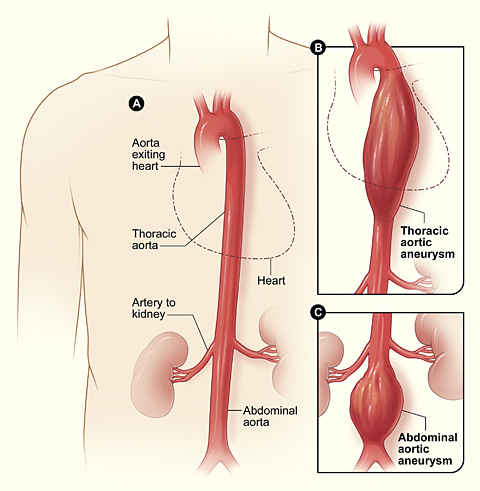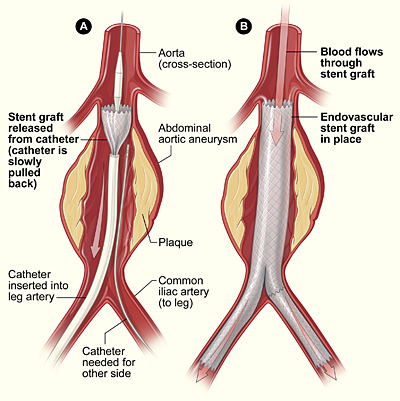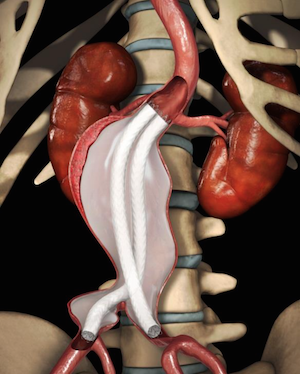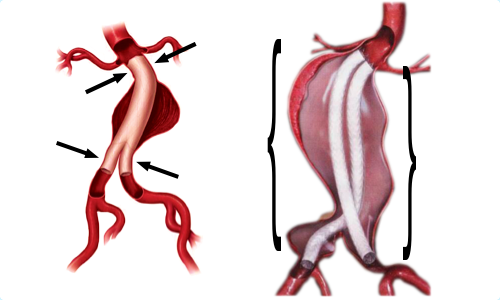Aneurysms (AAA)

What is an Aneurysm
An aneurysm is a swelling in an artery (or blood vessel). An abdominal aortic aneurysm (or AAA) occurs in the main blood vessel that comes out of the heart and descends down through the chest and into the abdomen supplying the guts, kidneys and other tummy organs. The aorta then divides in two to supply blood to the buttocks and legs.
The normal diameter of the abdominal aorta is 2 cm, anything over 3 cm is considered an aneurysm. As an aneurysm grows in size there is a risk that it can burst (rupture). If this happens there is significant bleeding and the result is often fatal. However, that risk is small when the aneurysm is small. Below 5 cm the annual rupture risk is small at < 0.5%
Symptoms
Most aneurysms do not cause any symptoms and so patients generally do not know they have an aneurysm. Some patients may feel a pulsatile swelling in their abdomen (tummy) and rarely the aneurysm can causes clots to fly of down to the legs and feet.
If an aneurysm ruptures (bursts) then the patient will get a sudden pain, usually in the back and possibly in the abdomen. The pain may spread down into the groin area. Because of the bleeding a patient may collapse and become pale.
A ruptured aneurysm is an emergency that a 999 ambulance should be called for.
Diagnosis
In most cases an abdominal aortic aneurysm can be diagnosed and screened for with a simple ultrasound test. The size of the aneurysm can be determined and if regular size measurements are required then the aneurysm can be followed using ultrasound too.
Treatments
At present treatment consists of three options.
- Regular ultrasound follow up measurements
- Open surgical repair
- Endovascular (minimally invasive) repair, known as EVAR or EVAS
- Stopping smoking
- Lowering cholesterol and starting on a statin tablet (e.g. Simvastatin). This has been shown to be of benefit even if your cholesterol is normal.
- Control of blood pressure
The operation to repair and aneurysm does have some risks. An abdominal aortic aneurysm that measures less than 5.5 cm has a very low risk of rupture and the risks of repair are greater. That is why it is usual for your surgeon to only offer a repair if your aneurysm measures 5.5 cm or greater or if your aneurysm starts to grow rapidly.
Open Surgical Repair
This is the traditional method of repairing an abdominal aortic aneurysm. Invariably a general anaesthetic is required and the operation involved the abdomen being opened for direct access to the aneurysm. The weakened area is then identified an clamps placed above and below that area to stop blood flow. The aneurysm is then opened and a synthetic graft is sewn in place to replace the weak section. This can either be a straight tube of one that splits like an upside down Y to the arteries that supply each leg.
This surgery takes about 3-6 hours and a patient can expect to stay in hospital for between 3 and 8 days.
Minimally invasive EVAR / EVAS

Endovascular aneurysm repair is a newer technique that works by lining the aneurysm from the inside. However, it now has been established practise for around 10 years.
Access to the aneurysm is obtained by small cuts in the groins exposing the femoral vessels. Guide wires are placed using x-ray guidance to visualise the inside of the body. The stent graft is then delivered along the wires into the correct position and released into place.
The most common stent graft (EVAR) procedure places the graft below the kidney arteries.
Not all aneurysms can treated with a standard stent graft that sits below the kidney arteries. And sometimes the blood vessels below the aneurysm prevent access and so a stent graft can not be placed.
If there isn't space below the kidney arteries to place a stent graft then a custom made device can be manufactured with holes for the kidney and gut arteries cut out to allow a graft to placed across them and little stents bridge between the main stent graft and the branch arteries. This is called a fenestrated or branched custom stent graft.
Nellix EVAS

The Nellix EVAS device was a minimally invasive (endovascular) aneurysm repair that worked in a new way, involving sealing the aneurysm. A standard device works by sealing at the top and bottom of the aneurysm, whereas the Nellix device works by sealing within the entire aneurysm. The stents have a expandable bag attached to them which is filled with a polymer during the repair. The polymer sets hard and seals the aneurysm.

A standard EVAR stent graft requires a straight length of artery at the top and bottom to seal against. The Nellix stent graft seals in a different way. The sealing bags that surround the stents can adapt to different shapes and so aneurysms that are irregular at the top or bottom can also be treated with this graft.